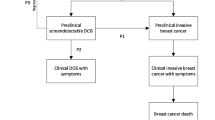Abstract
This paper is based on the idea that ductal breast cancer in situ (DCIS) precedes the invasive breast cancer (invBC), although the triple-negative invBCs almost lack their DCIS precursor. Reported incidences of breast tumor types in DCIS and in invasive BCs suggest that probabilities of tumor progression might differ among tumor types, and these differences can have some impact on our patients. Reported data from several papers on incidences of the four breast tumor types—luminal A, luminal B, HER2, and triple negative—are used to compare tumor-type incidences for DCIS and for the invasive BC. The pooled distributions differed (Χ 2 = 97.05, p < 0.0001), suggesting a strong selection pressure that reduces the number of triple-negative DCIS lesions at the time of breast tumor diagnosis. Reported shares of DCIS in all newly diagnosed breast cancers range in large screening trials from 9 to 26 %, so in making a population model, three values are arbitrarily chosen: one DCIS out of ten breast cancers (the 10 % share), one DCIS out of seven breast cancers (one seventh or the 14.3 % share), and one out of five (the 20 % share). By using these shares and the pooled data of tumor-type incidences, values are calculated that would be expected from a hypothetical population in which types of DCIS and invasive BC are distributed accordingly to the reported incidences. The model predicts that the shares of breast cancer tumor types in the modeled population (DCIS plus invasive BCs) are 39 % for luminal A, 20 % for luminal B, 11 % for HER2 positive, and 30 % for the triple-negative cancers. Some 59 % of all breast tumors are expected to be hormone receptor positive, and HER2 to be overexpressed in 31 %. Simulated probabilities of tumor progression were used to calculate the number of tumor progression t1/2 that has passed before the time of diagnosis. Calculated relative t1/2 durations in the modeled population suggest that the triple-negative DCIS cases were fastest in tumor progression, three times faster than the HER2-positive tumors and near twice as fast as luminal A. Luminal A is the model slower than luminal B DCIS, suggesting that although their progression depends on estrogen exposure, HER2 overexpression in luminal B tumors adds some speed in tumor progression. The model results suggest that quick tumor progression might be the main feature of the triple-negative breast tumors, leading to seldom triple-negative DCIS at the time of breast cancer diagnosis. Applying approach of the presented model to the real data from a well-defined population seems warranted.

Similar content being viewed by others
References
Hoffman AW, Ibarra-Drendall C, Espina V, Liotta L, Seewaldt V. Ductal carcinoma in situ: challenges, opportunities, and uncharted waters. ASCO Educational Book Manuscript 2012;40–4.
Dabbs DJ, Chivukula M, Carter G, Bhargava R. Basal phenotype of ductal carcinoma in situ: recognition and immunohistologic profile. Mod Pathol. 2006;19:1506–11.
Meijnen P, Peterse JL, Antonini N, Rutgers EJ, van de Vijver MJ. Immunohistochemical categorisation of ductal carcinoma in situ of the breast. Br J Cancer. 2008;98:137–42.
Bryan BB, Schnitt SJ, Collins LC. Ductal carcinoma in situ with basal-like phenotype: a possible precursor to invasive basal-like breast cancer. Mod Pathol. 2006;19:617–21.
Clark SE, Warwick J, Carpenter R, Bowen RL, Duffy SW, Jones JL. Molecular subtyping of DCIS: heterogeneity of breast cancer reflected in pre-invasive disease. Br J Cancer. 2011;104:120–7.
Carey LA, Dees EC, Sawyer L, Gatti L, Moore DT, Collichio F, Ollila DW, Sartor CI, Graham ML, Perou CM. The triple negative paradox: primary tumor chemosensitivity of breast cancer subtypes. Clin Cancer Res. 2007;13:2329–34.
Sorlie T, Tibshirani R, Parker J, Hastie T, Marron JS, Nobel A, Deng S, Johnsen H, Pesich R, Geisler S, Demeter J, Perou CM, Lonning PE, Brown PO, Borresen-Dale AL, Botstein D. Repeated observation of breast tumor subtypes in independent gene expression data sets. Proc Natl Acad Sci USA. 2003;100:8418–23.
Veer LJ, Dai H, Vijver MJ, He YD, Hart AA, Mao M, Peterse HL, Kooy K, Marton MJ, Witteveen AT, Schreiber GJ, Kerkhoven RM, Roberts C, Linsley PS, Bernards R, Friend SH. Gene expression profiling predicts clinical outcome of breast cancer. Nature. 2002;415:530–6.
West M, Blanchette C, Dressman H, Huang E, Ishida S, Spang R, Zuzan H, Olson Jr JA, Marks JR, Nevins JR. Predicting the clinical status of human breast cancer by using gene expression profiles. Proc Natl Acad Sci USA. 2001;98:11462–7.
Leonard GD, Swain SM. Ductal carcinoma in situ, complexities and challenges. J Natl Cancer Inst. 2004;96:906–20.
Zhou W, Jirström K, Johansson C, Amini RM, Blomqvist C, Agbaje O, Wärnberg F. Long-term survival of women with basal-like ductal carcinoma in situ of the breast: a population-based cohort study. BMC Cancer. 2010;10:653.
Latta EK, Tjan S, Parkes RK, O’Malley FP. The role of HER2/neu overexpression/amplification in the progression of ductal carcinoma in situ to invasive carcinoma of the breast. Mod Pathol. 2002;15:1318–25.
Hoque A, Sneige N, Sahin AA, Menter DG, Bacus JW, Hortobagyi GN, Lippman SM. Her-2/neu gene amplification in ductal carcinoma in situ of the breast. Cancer Epidemiol Biomarkers Prev. 2002;11:587–90.
Acknowledgment
This theoretic paper was financed through grant 219-2192382-2426 from the Croatian Ministry of Science, Education and Sport.
Conflicts of interest
None
Author information
Authors and Affiliations
Corresponding author
Rights and permissions
About this article
Cite this article
Kurbel, S. In search of triple-negative DCIS: tumor-type dependent model of breast cancer progression from DCIS to the invasive cancer. Tumor Biol. 34, 1–7 (2013). https://doi.org/10.1007/s13277-012-0602-1
Received:
Accepted:
Published:
Issue Date:
DOI: https://doi.org/10.1007/s13277-012-0602-1




